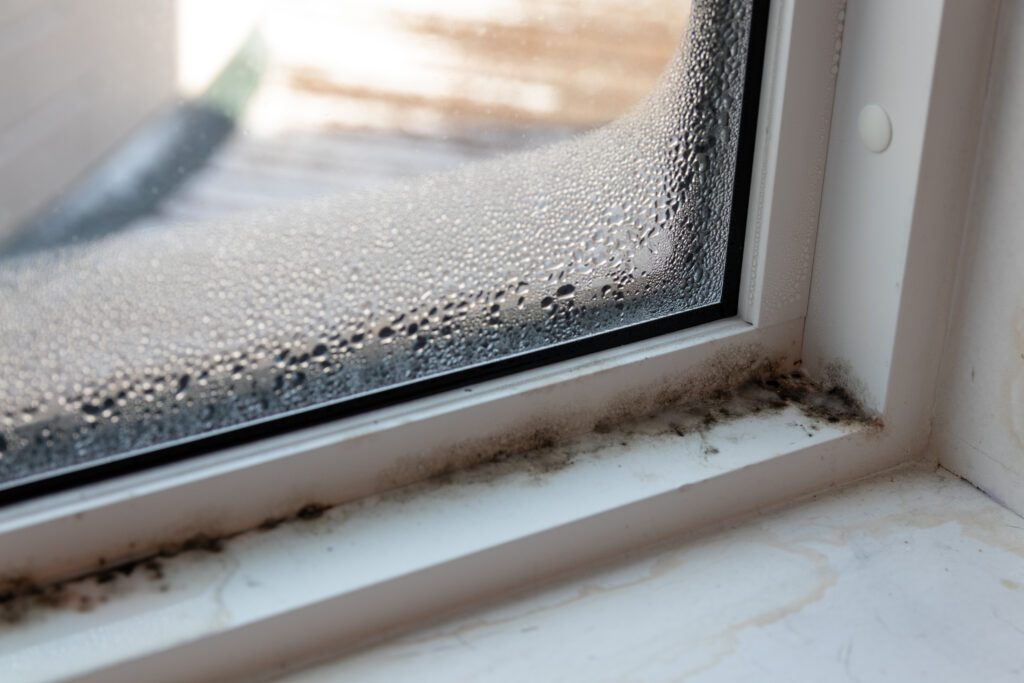Damp, condensation and mould are common issues that can affect any property. However, they are all preventable with proper care and attention. In this article, we will provide advice for both tenants and landlords on how to prevent these problems, as well as how to address them if they do occur.

Understanding Damp: Causes and Prevention
What Causes Damp?
Dampness in a property is typically caused by excess moisture. This can come from a variety of sources, including leaks in the roof, walls or plumbing, as well as poor ventilation. Damp can also result from rising moisture from the ground, which can be particularly problematic in older buildings that lack modern damp-proofing measures.
How to Prevent Damp
Preventing damp is often a matter of good property maintenance and vigilance. Here are some key steps to prevent damp:
- Regular Inspections: Landlords should conduct regular inspections of their properties to check for any signs of damp. Look for water stains on walls and ceilings, peeling paint or wallpaper, and musty smells. Early detection can prevent minor issues from becoming major problems.
- Proper Ventilation: Tenants need to ensure that the property is well-ventilated. This can be achieved by opening windows regularly, using extractor fans in kitchens and bathrooms and ensuring that air bricks are not blocked. Proper ventilation helps to reduce humidity levels, which can prevent damp.
- Repair Leaks Immediately: Any leaks, whether from the roof, pipes, or windows, should be repaired immediately. Even a small leak can lead to significant damp issues over time. Tenants should report leaks as soon as they occur.
- Use Dehumidifiers: In areas prone to damp, such as basements or poorly ventilated rooms, consider using a dehumidifier to reduce moisture levels in the air.
How to Deal with Damp
If you notice signs of damp, it’s important to act quickly. Identify the source of the moisture and address it immediately. This may involve repairing leaks, improving ventilation or installing damp-proofing measures. In severe cases, it may be necessary to consult a professional to assess the extent of the problem and recommend appropriate solutions.
Condensation: Causes and Prevention
What Causes Condensation?
Condensation occurs when warm, moist air comes into contact with cold surfaces, such as windows, walls or floors. This is particularly common in winter when indoor heating is high and outdoor temperatures are low. Common sources of moisture include cooking, bathing, drying clothes indoors and even breathing.
How to Prevent Condensation
Preventing condensation involves reducing moisture levels and improving air circulation. Here are some tips:
- Ventilate Rooms Regularly: Open windows daily to allow fresh air to circulate. Use extractor fans in bathrooms and kitchens to remove moisture-laden air.
- Avoid Drying Clothes Indoors: Drying clothes indoors, especially on radiators, can significantly increase moisture levels in the air. If possible, dry clothes outside or use a tumble dryer that vents outside.
- Use Trickle Vents: Modern windows often come with trickle vents that allow a small amount of air to flow through, helping to reduce condensation. Ensure these vents are open and not blocked.
- Maintain a Consistent Temperature: Keeping your home at a steady temperature can help reduce condensation. Avoid letting rooms get too cold, as this can increase the likelihood of condensation forming.
How to Deal with Condensation
If condensation does occur, it’s important to wipe down affected surfaces regularly to prevent mould growth. Consider using a moisture absorber or dehumidifier in rooms that are prone to condensation. If the problem persists, improving insulation or upgrading windows may be necessary to reduce cold surfaces where condensation forms.
Mould: Causes and Prevention
What Causes Mould?
Mould is a type of fungus that thrives in damp, warm and poorly ventilated environments. It often appears as black, green or white patches on walls, ceilings, and other surfaces. Mould can not only damage property but also pose health risks, particularly for individuals with respiratory conditions.
How to Prevent Mould
Preventing mould is closely linked to preventing damp and condensation. Here are some additional steps to take:
- Keep Surfaces Dry: Wipe down wet surfaces immediately, especially in kitchens and bathrooms. Ensure that tiles, shower screens, and windowsills are kept dry.
- Regular Cleaning: Regularly clean areas that are prone to mould growth, such as bathrooms and kitchens, using mould-resistant products. Pay special attention to corners and hidden areas.
- Improve Insulation: Poorly insulated properties are more susceptible to mould due to cold surfaces. Upgrading insulation in the walls, roof and windows can reduce the likelihood of mould forming.
- Use Anti-Mould Paint: In areas that are particularly prone to mould, such as bathrooms, consider using anti-mould paint. This type of paint contains fungicides that help prevent mould growth.
How to Deal with Mould
If mould does appear, it’s crucial to act quickly to remove it. Use a mould removal spray or a solution of bleach and water to clean affected areas. Always wear protective gloves and a mask when dealing with mould to avoid inhaling spores. If the mould is extensive, it may be necessary to hire a professional to safely remove it.
The Importance of Regular Inspections and Maintenance for Landlords
For landlords, preventing damp, condensation and mould is not just about protecting the property but also about ensuring the health and wellbeing of tenants. Regular inspections and proactive maintenance are key to preventing these issues from arising. Landlords should also encourage tenants to report any problems as soon as they notice them, allowing for prompt action to be taken. Whether you are a landlord looking to maintain your property or a tenant wanting to ensure a healthy living environment, preventing damp, condensation and mould should be a top priority. Regular inspections, good ventilation and prompt repairs are essential to keeping your property in top condition. If you need assistance with property maintenance or have concerns about damp, condensation or mould, contact Belvoir Tunbridge Wells today. Our experienced team is here to help.










